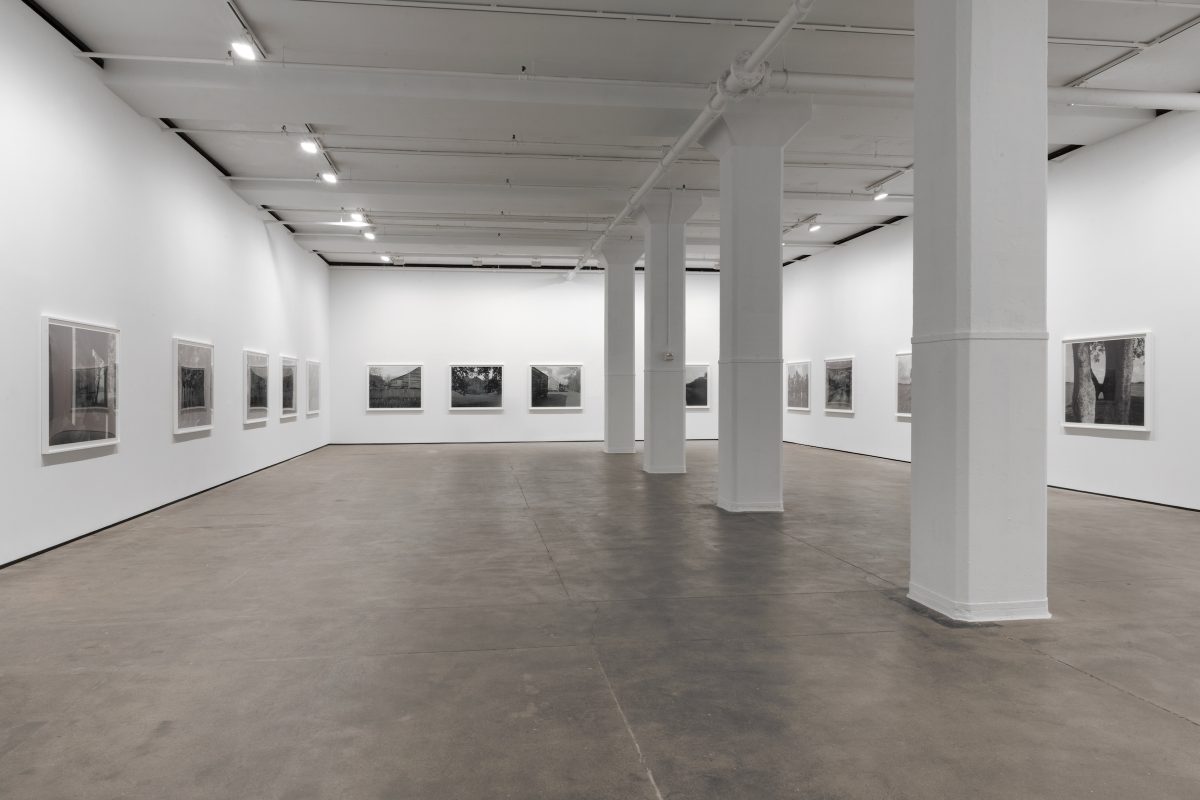
If you want to come into an intimate understanding of what Dawoud Bey is doing with the images in his exhibition In This Here Place, at Sean Kelly gallery you can just listen to his voice. When I visited the show, a member of the gallery staff showed me how they had installed next to each framed photograph in the main gallery a mechanism which uses near field communication (NFC) technology to allow my smartphone to access an audio file Bey made to accompany each work. His voice has a grandfatherly sound, weathered and measured. Beyond being surprised to hear Bey speaking, I find the commentary helpful because he discusses — specifically when talking about the work “Trees and Barn” (2019) — what for me is the fulcrum of the exhibition. “And that of course is one of the paradoxical things about the work overall … the work is about the tension between those two things: the fundamental beauty of the photographic object as it relates and bangs up against the horror of the history that it describes.” Unless you were already familiar with Bey’s documentary work, or have done your own extensive reading on the history of slavery in the United States, the horror might not be recognizable to you. The photographs are deceptive.
Both in their display arrangement and in their resolutely serene compositions the photographs are muted. They also feature very deliberate formal layouts. In “Open Window” (2019) a picket fence intersects the outside wooden wall of a simply constructed cabin. The sunlight lands at such an angle that the left side of the image is enveloped in darkness. However, at the right side, in the distance, there is a tree with a jutting branch that echoes the horizontal wood slats of the cabin wall. And in that namesake open casement window a tattered and torn bit of muslin or burlap, which cannot serve as a proper shade, suggests that the house is abandoned or owned by someone who is desperately indigent. Bey’s narration lets me know that this is part of five plantations that he has explored in the series (in Louisiana, at the Evergreen, Destrehan, Laura, Oak Alley, and Whitney plantations).

These images are all elegies, made with the cool, almost cold, assessment of an historian, and the poise with which he constructs these images feels like it has deepened over time. Bey has long been at this work. This is the third iteration in his history series which began with The Birmingham Project, (2012), which paid tribute to the victims of the 16th Street Baptist Church bombing in Birmingham, Alabama and continued with the second series, Night Coming Tenderly, Black (2017). The Whitney Museum earlier this year displayed images from The Birmingham Project as part of a large retrospective of Bey’s work. There each image was a diptych, one side containing a sitter who was then the same age as the children murdered in an infamous church bombing, while the other side featured an adult 50 years older — how old those children would be now had they survived. I also saw the photographs from
Night Coming Tenderly, Black which were on display at the Art Institute of Chicago in early 2019. There, like here, the images are starkly uninhabited. They rely very much on the context created by Dawoud Bey’s written narration, institutional framing, and whatever the viewer brings with them.
The work is very much about bearing witness. It is meant to point to a still festering wound in our collective historical body. It is perhaps paradoxical for me (an atheist) to quote from the Old Testament, but the passage speaks well to what I think Bey sees and hears and feels he must convey to us. After Cain kills his brother Abel, he is accused by his god who witnessed the murder: “‘What have you done? Listen; your brother’s blood is crying out to me from the ground.” The blood of those brutalized by the regime of chattel slavery and a system of violent white supremacy still calls out. Bey is listening and translating and each time I see his work I wonder how much is both gained and lost in the paraphrase.
In This Here Place, continues at Sean Kelly gallery (475 Tenth Avenue, Midtown, Manhattan) through October 23.
0 Commentaires